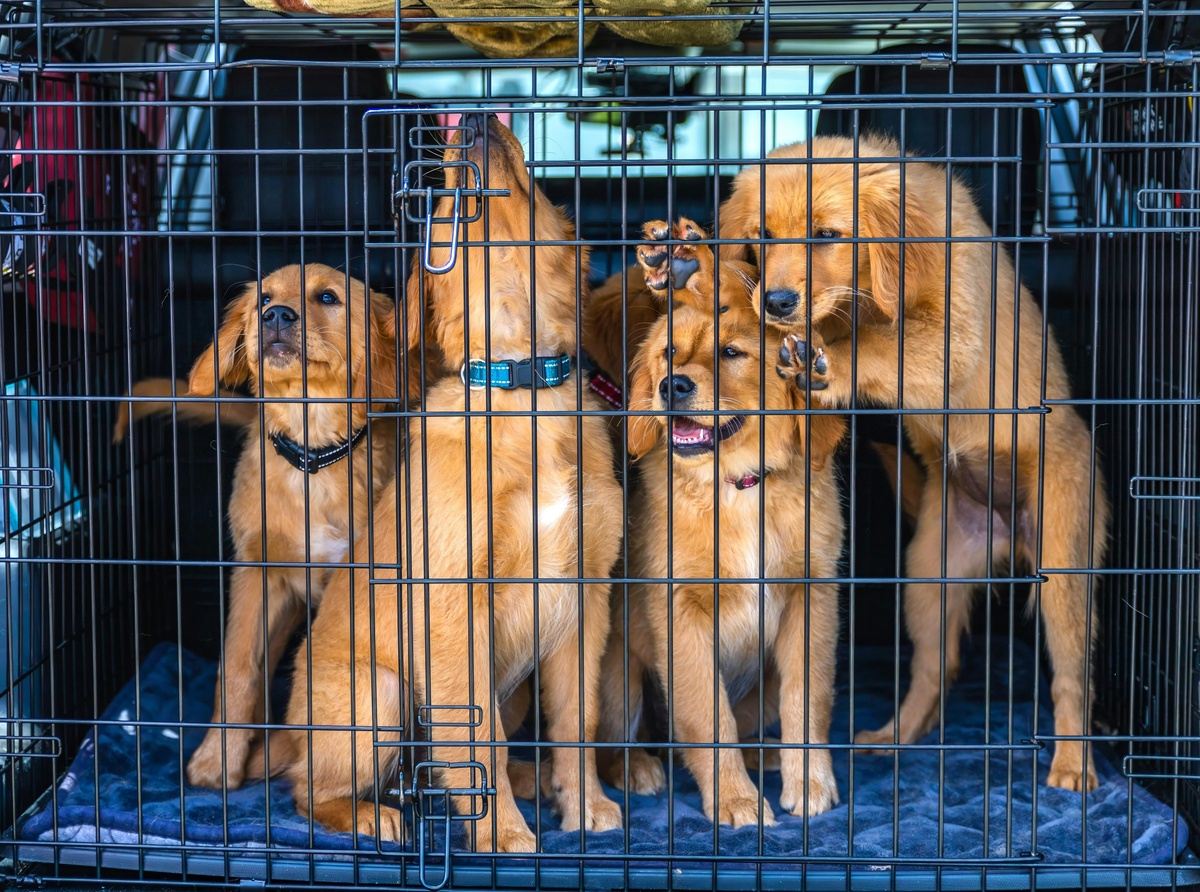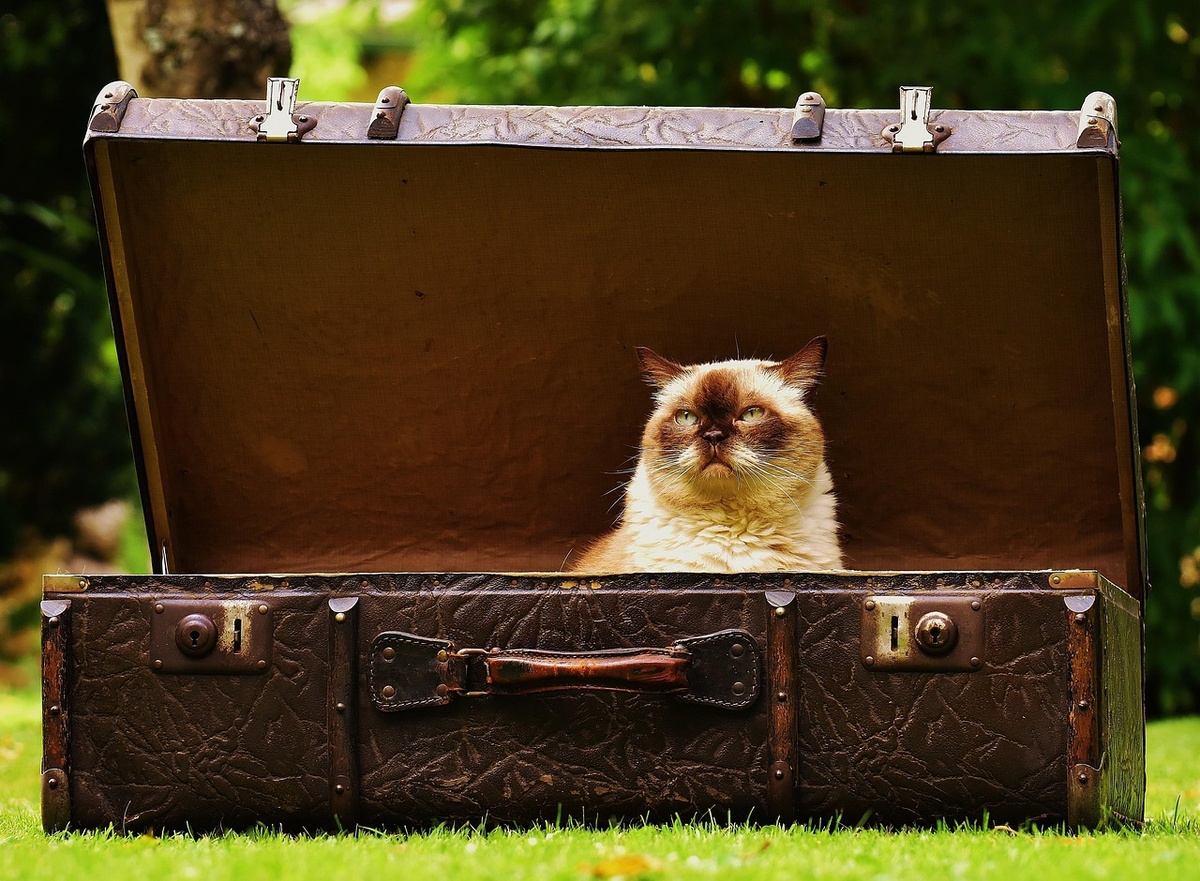
Travelling with Dogs & Cats on Planes – Everything You Need to Know
Whether you’re travelling with a dog or a cat, pet air travel can be quite a stressful ordeal. Luckily, there are ways to make the trip as smooth as possible for you and your four-legged friend. From airline regulations to smart preparation and your legal rights, there’s a lot to think about when you choose to take your pet on board. In this article, we’ll tell you everything you need to know about flying with a cat or dog, which airlines allow pets in the cabin, how to transport your pets, and what to do if your flight is delayed or cancelled. You might even be entitled to compensation. By being well-prepared and informed, you can help ensure a comfortable and stress-free journey for both you and your beloved pet.
Before the flight
Check the airline regulations regarding travelling with pets
When it comes to flying with your dog or cat on planes, every airline is different in their regulations and policies. So it’s vital that you take the time to fully research the airlines you’re considering booking with and get a clear understanding of what’s involved in travelling with your pet by air. Head to the airline’s website or give them a call on their helpline to find out what they require. You’ll need to find out if the airline allows the pet to travel in the cabin with you or if it has to travel in the cargo hold. This will usually depend on the size/weight of the animal and the size of its carrier bag.
Make sure the pet carrier bag fits within the airline’s guidelines —otherwise, you might run into problems at the airport. Also, some countries (and airlines) require a veterinarian health certificate declaring your pet is healthy enough to fly, issued no more than 48 hours before the flight (the time varies depending on the airline). You’ll also need to check if there are any restricted or forbidden breeds, especially if you’re thinking of travelling with a brachycephalic (short-nosed) dog breed. These breeds are particularly vulnerable to altitude sickness, which can develop quickly. Since they suffer from overheating and breathing difficulties, these dogs are not allowed to travel in the cabin.
All in all, checking airline regulations will spare you a lot of trouble before and after the flight, making your travel experience with your four-legged friend way much easier. So don’t be afraid to get in touch with the airline —it’s their job to help you with your travel plans. And if you’re dealing with an airline that’s part of a larger airline group, like Thomas Cook or Lufthansa, make sure you check all the different airlines’ policies since each has different rules and regulations. In case your flight gets delayed or cancelled, don’t forget to check if you’re eligible for compensation . It could mean savings of hundreds of pounds.
Reserve a ticket for your pet
When flying with dogs on planes, most airlines require you to reserve a spot for your pet, as they typically permit a limited number of animals on each flight. To secure a spot, it's crucial to make your reservation as early as possible and to confirm it before your travel date. This early booking helps ensure that your pet has a guaranteed place and avoids any last-minute disappointments. Additionally, checking with the airline about their specific policies regarding pet travel is essential, as requirements can vary widely. For example, some airlines might have restrictions on the size or breed of dogs they allow, and others might have specific guidelines for the type of carrier you can use. By understanding these details and planning ahead, you can help ensure a smooth and hassle-free travel experience for both you and your furry companion.
Go see your vet
The pre-flight veterinary check is crucial for ensuring your pet's health and safety during travel. This step is essential to confirm that your dog or cat is healthy enough to fly and to discuss any potential risks or concerns with your veterinarian. Your vet can provide valuable guidance on several key areas, ensuring that your pet is well-prepared for the journey:
Health Certificates: Many airlines and destinations require a health certificate for traveling pets. Your vet can issue this document, certifying that your pet is in good health and fit to fly.
Vaccinations: It's important to ensure that your pet's vaccinations are up to date. This not only protects your pet from diseases but is also often a legal requirement for travel. Your vet will check your pet’s vaccination records and administer any needed shots.
Sedatives: For some animals, the stress of travel can be overwhelming. Discuss with your vet whether sedatives might be appropriate for your pet. They can recommend safe and effective options to help keep your pet calm during the flight.
In addition to these points, your vet might also provide tips on feeding schedules before the flight, advice on managing anxiety, and recommendations for travel-friendly carriers. This comprehensive preparation can help ensure a safe and comfortable experience for your pet during air travel.
Packing Essentials for Your Pet
Packing the right items can significantly enhance the comfort and well-being of your pet during travel. Ensuring you have all the necessary supplies will help your pet feel secure and cared for throughout the journey. Essential items to pack include:
Carrier: Use an airline-approved pet carrier that is well-ventilated and provides enough space for your pet to stand, turn around, and lie down comfortably. Make sure it meets the size requirements set by your airline, especially if your pet will be traveling in the cabin.
Comfort Items: Bring along a familiar blanket or toy to provide a sense of familiarity and comfort for your pet. These items can help reduce stress and anxiety by reminding your pet of home.
Food and Water: Pack enough food and water for the entire journey, including any layovers or delays. Use spill-proof containers or collapsible bowls for convenience. It’s also a good idea to bring some of your pet's favorite treats to keep them happy and calm.
Leash and Harness: These are essential for moving through the airport and passing through security checks. A sturdy leash and harness ensure you can keep your pet under control and safe. Additionally, having these items handy will be useful once you arrive at your destination.
Health Documents: Carry all necessary health certificates, vaccination records, and any other required documentation. Having these papers easily accessible will help streamline the check-in process and avoid any potential issues.
Waste Disposal Supplies: Bring along waste bags and any cleaning supplies you might need to clean up after your pet during the journey. This is especially important for long trips or layovers.
Medications: If your pet requires any medications, be sure to pack them in your carry-on bag. Keep a copy of the prescription and dosage instructions in case you need to explain their use to airline staff.
By preparing these essential items, you can help ensure that your pet remains comfortable, secure, and well-cared for throughout the travel experience. Proper preparation can make a significant difference in reducing stress and ensuring a smooth journey for both you and your furry companion.

Image by Alexa from Pixabay.
At the Airport
Check-In Process
Though this advice isn't limited to flying with dogs, we can't stress enough how important it is to arrive early to handle the check-in process when traveling with pets. Even at pet-friendly airlines, it's crucial to inform the airline staff that you are traveling with a cat or dog and ensure all documentation is in order. Arriving early allows you ample time to navigate any unexpected issues that might arise, such as long lines or additional paperwork requirements.
Moreover, early arrival provides you with the opportunity to calmly check that your pet's carrier meets airline specifications and that your pet is comfortably settled. This is also the time to confirm that your pet's health certificates, vaccination records, and any other required documents are properly filled out and readily accessible. Informing the staff about your pet in advance can help ensure that your pet is handled with care throughout the boarding process and that any special accommodations are noted and provided. By giving yourself extra time, you can reduce stress for both you and your pet, leading to a smoother and more pleasant travel experience.
Security Screening
When traveling with dogs or cats, your pets will need to go through security screening. Typically, this process involves removing your pet from its carrier, as both the pet and the carrier will be screened separately. It’s important to prepare for this step to ensure a smooth and stress-free experience.
First, familiarize your pet with the process of being taken out of its carrier in a controlled environment. Practicing this at home can help reduce anxiety for both you and your pet. When you arrive at the security checkpoint, be ready to quickly and calmly remove your pet from the carrier, holding it securely to prevent any attempts to escape.
The empty carrier will be placed on the conveyor belt to go through the X-ray machine, while you carry your pet through the metal detector or a designated screening area. Be sure to have a firm grip on your pet or use a harness and leash to maintain control. After the screening, you can return your pet to its carrier and proceed to your gate.
By being well-prepared and understanding what to expect during the security screening process, you can help make this part of the journey as seamless as possible for your pet.
Managing Layovers
Some airports provide designated areas where dogs and cats can relieve themselves, known as pet relief areas. If your flight includes layovers, it's a good idea to check the airport facilities for these pet-friendly spots in advance. Utilizing these areas can help keep your pet comfortable and minimize accidents during the journey.
Also, take advantage of these designated areas to give your pet a chance to stretch, relieve themselves, and get a break from the confines of their carrier. This can significantly reduce your pet’s stress levels and contribute to a more pleasant travel experience for both of you. By planning ahead and knowing where these facilities are located, you can ensure that your pet remains comfortable and well-cared for throughout your journey.
In-Flight Experience
Cabin or Cargo
Depending on your pet's size, your dog or cat may be permitted to travel in the cabin with you, or they may need to travel in the cargo hold. Small pets, such as cats and small dog breeds, can often travel in the cabin under the seat in front of you, provided they are in an airline-approved carrier. This allows you to keep your pet close and monitor them throughout the flight, which can be comforting for both you and your pet.
Larger pets, on the other hand, will typically need to travel in the cargo hold. While this may sound concerning, it’s important to note that the cargo area designated for pets is temperature-controlled and pressurized, ensuring a safe and comfortable environment for your pet. Airlines that transport pets in the cargo hold have strict regulations and procedures to ensure their safety and well-being during the flight.
Keeping Your Pet Calm
Having a cat on plane journeys can be quite stressful for your furry friend. It's important to keep them calm and relaxed during the flight. One of the best ways to soothe your pet is by offering reassurance. Talk to them in a calm and gentle voice, letting them know that everything is okay. Throughout the flight, make sure to provide comfort and support. This familiar interaction can help ease their anxiety and make the journey more comfortable for them.
When it comes to calming methods, it's generally best to avoid using sedatives —unless specifically advised by your vet. Sedatives can sometimes have negative effects, such as causing difficulty in breathing, which can be dangerous during a flight. Instead, focus on natural ways to keep your pet calm. To keep them comfortable and healthy, ensure they have access to water to stay hydrated, as proper hydration is crucial, particularly on long flights.
By keeping these considerations in mind, you can significantly enhance your pet's flying experience.

Image by Alex P from Pexels.
Handling Flight Disruptions
Flight disruptions can be stressful, especially when flying with a dog. It's important to understand your rights. Knowing how to handle such situations can make a significant difference.
Flight Delays and Cancellations
Travelling with dogs can be challenging, particularly if you encounter flight delays or cancellations. The first thing you should do in such cases is to seek help from the airline staff. They can provide you with information about the current situation and may offer alternative options if necessary. Additionally, you can look for pet relief areas in the airport, where your dog can take a break during long waits. These designated areas allow pets to relieve themselves and stretch their legs a bit.
If the delay or cancellation requires you to rebook, make sure to do so promptly to minimise further disruptions to your travel plans. It's crucial to make sure your pet remains comfortable and calm during this process. Keep them close and provide reassurance throughout the waiting period. By staying proactive and well-informed, you can effectively manage delays and cancellations, ensuring a smoother journey for both you and your pet.
Compensation Claims
Under EC 261, if your flight is delayed, cancelled or overbooked, you might be entitled to compensation. AirHelp can assist you in filing a claim.
In certain cases, compensation may cover:
Delays: If your flight is delayed for more than 3 hours, you may be entitled to compensation of up to £520.
Cancellations: If your flight is canceled with less than 14 days' notice, you may be eligible for compensation of up to £520.
Denied Boarding: If you are denied boarding due to overbooking, you could receive compensation of up to £520.
Luggage Problems
Lost or Delayed Pet Carriers
If your pet's carrier gets lost during travel, you may be entitled to compensation for the inconvenience and potential distress caused to both you and your pet. It's crucial to take immediate action by reporting the issue at the airline's luggage desk as soon as you notice the carrier is missing. Request assistance from the staff to initiate a Property Irregularity Report (PIR), which documents the details of the lost carrier.
Provide as much information as possible about the carrier, including any unique identifiers or tags attached to it. This report helps the airline track down your pet's carrier and facilitates communication regarding its recovery.
In addition to filing a PIR, inquire about interim measures to ensure your pet's well-being, such as providing a temporary carrier or accommodations until the original carrier is found or replaced. Stay in contact with the airline's customer service or baggage handling team for updates on the search efforts and to discuss any compensation that may be due.
Overbooking Issues
Experiencing an overbooked flight and being denied boarding can be particularly stressful when travelling with a pet. In such situations, it is crucial to remain calm. Immediately seek assistance from the airline staff. Request alternative arrangements, such as being placed on the next available flight or securing different transportation options to accommodate both you and your pet. It is also important to understand your rights regarding compensation.
Airlines are typically required to provide compensation for inconveniences caused by overbooking. Ensure you ask the airline staff about your entitlement to compensation. Follow up accordingly. Keeping your pet's comfort in mind during this time is essential. Try to keep them calm and reassured until you can board an alternative flight. By staying informed and proactive, you can better navigate the challenges of overbooking, ensuring a smoother travel experience for you and your pet.
Frequently asked questions about dogs on planes
Can you take a dog on a plane?
You are allowed to take a dog on a plane. Always inform the airline in advance and arrive early at the airport. Check the airline's pet policy, and ensure you have a suitable carrier. Small dogs can often travel in the cabin, while larger dogs may need to travel in the cargo hold.
What are the best practices for travelling with a pet?
Ensure your pet is healthy. Familiarise yourself with airline policies. Book in advance and pack all necessary items, including a comfortable carrier with food and water.
What should I do if my pet is stressed during the flight?
Speak to your pet as calmly as you can while offering comfort items. Unless prescribed by a vet, avoid sedatives and ensure your pet stays hydrated.
How do I handle flight delays with a pet?
Keep yourself informed by speaking with airline staff. Also, be sure to use pet relief areas whenever you can. Most importantly, ensure your pet remains comfortable and hydrated.
What if my pet’s carrier is lost or damaged?
If your pet's carrier is lost, you should report it immediately at the airport's luggage desk. Be sure to ask for a Property Irregularity Report (PIR) and keep receipts for any replacement items. Afterwards, you can submit a compensation claim.